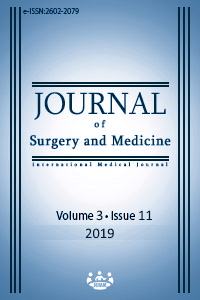Survival outcomes of percutaneous endoscopic gastrostomy, comparison of cerebrovascular event and non-cerebrovascular event in malnourished patients
Keywords:
Cerebrovascular events, Enteral nutrition, Percutaneous endoscopic gastrostomyAbstract
Aim: The number of comorbid diseases increased with the rise in the elderly population. In some cases, the state of deficient or absent nutrition emerges. Nevertheless, the contribution of percutaneous endoscopic gastrostomy (PEG) to the quality of life and the survival rate in the elderly with certain diseases remains controversial.
Methods: In this prospective cohort study, patients who underwent percutaneous endoscopic gastrostomy (PEG) procedure between 2009 and 2015 were divided into two groups: CVE group consisted of patients with cerebrovascular event (CVE) and non-CVE group comprised patients who suffered from esophageal tumors, head and neck tumors, brain tumors, amyotrophic lateral sclerosis and terminal dementia. In this study, the patients' pre-PEG and post-PEG body mass index (BMI) values, hemoglobin (Hb), albumin (alb), creatinine (Cr) and C-reactive protein (CRP) values, white blood cell counts, demographic characteristics, 30, 90, 180 and 365 day-survival rates, complications (mechanical, metabolic and infectious) and duration of patency of the PEGs were compared.
Results: The average age was lower while survival rate on the 90th day was higher in the CVE group. No significant difference was found in terms of other parameters. At the end of the one-year follow-up, 21% of the patients in the CVE group and 12% of those in the non-CVE group were able to be fed without PEG.
Conclusion: PEG patency was higher in the CVE group at 3 months but there was no statistically significant difference between the groups at one-year and overall follow-up periods.
Downloads
References
Volkert D, Berner YN, Berry E, Cederholm T, Coti Bertrand P, Milne A, et al. ESPEN guidelines on enteral nutrition: geriatrics. Clin Nutr. 2006;25:330-60.
Şimşek KB, Özer G. Evaluation of stroke mortality and related risk factors: A single-center cohort study from Gaziantep, Turkey. J Surg Med. 2019;3(3):231-4.
Song RR, Tao YF, Zhu CH, Ju ZB, Guo YC, Ji Y. Effects of nasogastric and percutaneous endoscopic gastrostomy tube feeding on the susceptibility of pulmonary infection in long-term coma patients with stroke or traumatic brain injury. Zhonghua Yi Xue Za Zhi. 2018 Dec 25;98(48):3936-40.
Joundi RA, Saposnik G, Martino R, Fang J, Kapral MK. Timing of Direct Enteral Tube Placement and Outcomes after Acute Stroke. J Stroke Cerebrovasc Dis. 2019 Sep 28:104401.
Bayraktar Y, Koseoglu T, Sivri B, Kansu T, Kayhan B, Varli K, et al. PEG in patients with complete dysphagia due to neurological diseases. Turk J Gastroenterol. 1993;4(4):664-7.
Muftuoglu M, Erturk O, Karinoglu M, Gurer S, Yilmaz H, Akin O, et al. PEG in neurological diseases: Indications and complications. Turk J Gastroenterol. 1995;6(1):128-31.
Skelly RH, Kupfer RM, Metcalfe ME, Allison SP, Holt M, Hull MA, et al. Percutaneous endoscopic gastrostomy (PEG): change in practice since 1988. Clin Nutr. 2002;Oct;21(5):389-94.
Callahan CM, Haag KM, Weinberger M, Tierney WM, Buchanan NN, Stump TE, et al. Outcomes of percutaneous endoscopic gastrostomy among older adults in a community setting. J Am Geriatr Soc. 2000;48:1048-54.
Fisman DN, Levy AR, Gifford DR, Tamblyn R. Survival after percutaneous endoscopic gastrostomy among older residents of Quebec. J Am Geriatr Soc. 1999;47:349-53.
Fraser GM, Abuksis G, Mor M, Segal N, Shemesh I, Plout S, et al. Percutaneous endoscopic gastrostomy: high mortality rates in hospitalized patients. Am J Gastroenterol. 2000;95:128-32.
Ha L, Hauge T. Percutaneous endoscopic gastrostomy (PEG) for enteral nutrition in patients with stroke. Scand J Gastroenterol. 2003;9:962-6.
Mitchell SL, Tetroe JM. Survival after percutaneous endoscopic gastrostomy placement in older persons. J Gerontol A Biol Sci Med Sci. 2000;Dec;55(12):735-9.
Blomberg J, Lagergren P, Martin L, Mattsson F, Lagergren J. Albumin and C-reactive protein levels predict short-term mortality after percutaneous endoscopic gastrostomy in a prospective cohort study. Gastrointest Endosc. 2011;Jan;73(1):29-36.
Malmgren A, Hede GW, Karlström B, Cederholm T, Lundquist P, Wirén M, et al. Indications for percutaneous endoscopic gastrostomy and survival in old adults. Food Nutr Res 2011; 55:6037.
James A, Kapur K, Hawthorne AB. Long-term outcome of percutaneous endoscopic gastrostomy feeding in patients with dysphagic stroke. Age Ageing 1998;Nov;27(6):671-6.
Dennis MS, Lewis SC, Warlow C; FOOD Trial Collaboration. Effect of timing and method of enteral tube feeding for dysphagic stroke patients (FOOD): a multicenter randomized controlled trial. Lancet 2005;365:764-72.
Smithard DG, O'Neill PA, England RE, Park CL, Wyatt R, Martin DF et al. The natural history of dysphagia following a stroke. Dysphagia 1997;Fall;12(4):188-93.
Gordon C, Hewer RL, Wade DT. Dysphagia in acute stroke. Br Med J (Clin Res Ed). 1987 Aug 15;295(6595):411-4.
Downloads
- 903 1235
Published
Issue
Section
How to Cite
License
Copyright (c) 2019 Yaşar Küçükardalı, Murat Hakan Terekeci, Arzu Yalçın, Rahman Nurmuhammedov, Cengiz Pata, Sibel Temür, Ferda Fatma Kartufan, Hakan Şilek, Nazlı Şişik Yaltırık, Elif Çiğdem Altunok
This work is licensed under a Creative Commons Attribution-NonCommercial-NoDerivatives 4.0 International License.
















